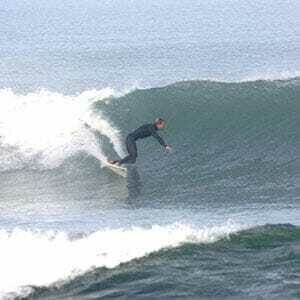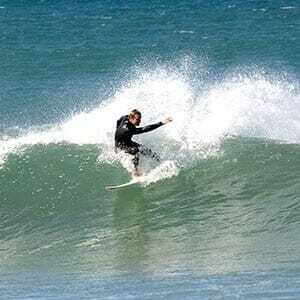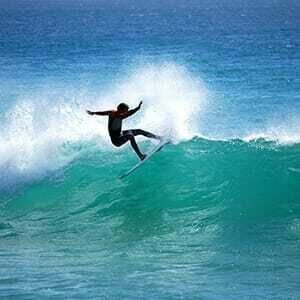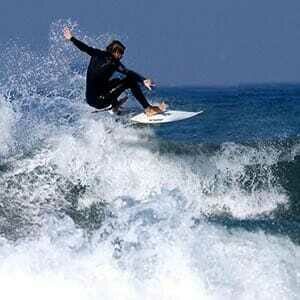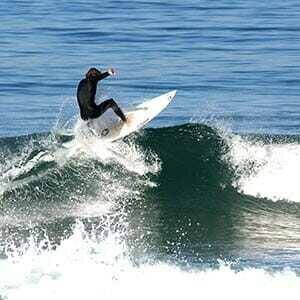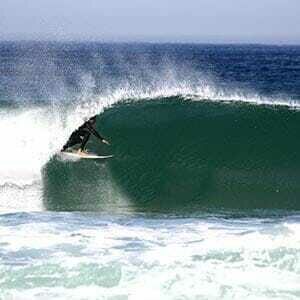
Surf tricks
Here you can find an overview of first surf moves
The Bottom Turn
To carve on the water, there are a few techniques. This way you can make turns quickly and get momentum for other maneuvers.
To do this, you make the so-called bottom turn. Use this to gain momentum after you have driven down the shaft. Turn your shoulder in the desired direction and press the corresponding rail into the water. Depending on whether you surf frontside, facing the wave, or backside, facing away from the wave, the basic rule is: you surf where you look or where you turn your upper body.
The most important thing is to have the right weight shift on the edge of your board and that you lean heavily into the turn with your upper body. This works best by bending over so that you can touch the water wall of the wave with your hand.
The more you work with your upper body, the more power and speed you build.
The backside turn is often perceived as more difficult because you surf with your back to the wave.
The cutback
To “brake” the cutback helps. you do a very tight turn at the top of the wave, usually with a spray.
You do this, almost exactly like ‘normal’ carving, by shifting your weight correctly.
The most important thing is the strong weight shift. With the cutback, you have to load your back foot particularly strongly and for a longer period of time – as a result, you slow down more or the spray gets better.
The advantage of cutback is slowing down and “going backwards”. The waves are often different speeds in some places and you have to constantly adjust your speed.
Only with a cutback is it possible to surf slower waves. If you don’t change your speed, you often don’t reach the so-called curl in time.
Snap Tailslide
A snap is a hard turn of about 90° at full speed to make a spray. Very similar to skateboarding.To ride the snap you need a little more momentum than the usual turns. Here you surf along the wave as usual until you reach the highest point – here you now turn jerkily and “jump” into a turn of almost 90°.
After the power turn, you continue to sled with your board. With this move, your fins will no longer provide support and your board will become very unstable. For this reason, it is particularly difficult to keep yourself on the surfboard. Always try to keep your upper body above your board!
You have to be very precise for the snap to succeed. So it happens more often that with too much load you are no longer stable and slips away. However, if you don’t lean back far enough, your board won’t ‘slide’.
Aerial
The Aerial is considered one of the most difficult tricks among surfers. To learn this one you need a lot of practice, previous knowledge and good conditions.
Behind the name is nothing more than a jump with which you leave the wave together with the board and land again shortly after in the same wave.
To learn an aerial there are several ways. On the one hand, you can chase yourself out over the wave with a normal jump. For this, the tail is pressed down with your foot to be able to jump off, similar to the ollie in skateboarding.
Another possibility lies in the technique Off the Lip. Here you ride with full power and speed towards the top edge of the wave and catch the lip in total vertical. So you ‘drive’ out of the wave, so to speak. However, this is often a very reckless method and therefore not really recommended for beginners.
The landing, the so-called re-entry, also has to be learned. Here, as with the other techniques, it depends on the correct weight distribution. The location is rather secondary here. After your aerial you can land in the broken wave as well as in the green of the waves.
It’s often easier if you dig your board.
360 Threesixty
As in almost all board sports where only one board is used, there is also a three-sixty in surfing. Even for beginners, the movement sequence can be learned quickly.
Here you ride a hard turn at the bottom of the wave and then ride up the wave. The most important thing now is the inclined position of your board. due to the oblique approach, you have already started with part of the rotation. The water then presses on the outer edge of the board, pushing it further into the turn. So the harder you lean, the easier it is for your board to turn in the wave. Always make sure that you turn your upper body strongly and try to look back in the direction of travel!
Surfing can sometimes be a short pleasure, especially for beginners – especially when the waves break very fast.
When you see that the wave is ‘closing’, you must shoot towards the lip of the wave with a lot of force, pretty much parallel to the wave. The goal is to catch the lip so that you ride ‘on’ it. This works best if you take some weight off your board and get nice and bent at the knees. The important thing now is the correct body position to the water – make sure your body stays in the wave even though you are pushing your board against the lip.
Tuberiding
Tuberiding is considered among surfers as the ‘supreme discipline’ of tricks. Here you are actually just riding in a wave tube. Easier said than done…
The hardest part of tuberiding is getting in and out and having an eye for the wave, when to speed up or slow down
In the best case, you surf the wave already in deep water until it finally breaks over you in shallower water.Now that you are in the tube, it is important to move forward quickly and leave it standing again. The waves often break too fast and crash up on you….
Note that serious injuries can occur here. The waves break in shallow water (otherwise they would not form a tube). If you notice that you are too slow, it is best to dive through the back of the wave. If the wave catches you, there is a wash that has it in itself – It is important above all to keep the board under control, or to protect your head, because you are simply washed through uncoordinated.
Basically, waves suitable for Tuberides are more likely to be found in shallow water. Here, the wave not only breaks, but builds up in height until it rolls over.
